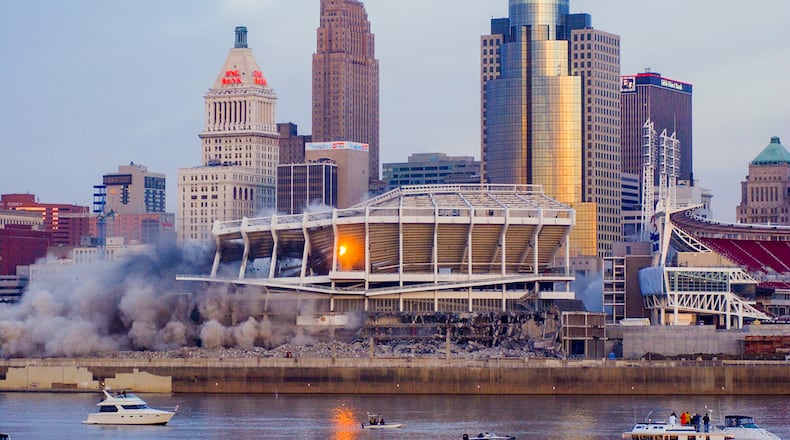The historic stadium came down in just 37 seconds on December 29, 2002. The blast of 1,275 pounds of strategically placed dynamite leveled the stadium and turned the once state-of-the-art bowl into 100,000 cubic yards of rubble.
PHOTOS: Fans said goodbye to Riverfront Stadium/Cinergy Field in Sept. 2002
WCPO was there that day and captured all the excitement and memories.
The implosion brought out thousands of people to watch the spectacle. They packed into office towers, hotels, restaurants and along the Kentucky bank – to watch Cincinnati history and say goodbye to the landmark stadium.
At 8 a.m., onlookers saw flashes of light rotate in a counterclockwise direction as explosions ripped through the concrete supports. Then came the rumbling and crashing of thousands of tons of concrete into the center of the bowl. Dust and smoke rose 200 feet, obscuring the view from some of downtown’s tallest towers, but the cloud dissipated in 15 minutes.
One man, watching from the plaza level at Paul Brown Stadium, summed it up in one word.
“Amazing,” Joe Nuxhall said.
The stadium once hosted the Bengals and the Reds. It was home to the “Big Red Machine” of the 1970s. The stadium once saved the Reds from moving out of town, brought pro football to the Queen City and started the revitalization of the city’s riverfront.
From 1970 to 1996 it was home to some of the greatest legends and moments in Cincinnati sports.
Here are a few of those major moments:
- The ballpark gave birth to the Big Red Machine, with its four World Series in the 70s and two World Championships, and another wire-to-wire championship team in 1990. Four Hall of Famers emerged from the BRM, including Joe Morgan, Johnny Bench, Tony Perez and Sparky Anderson. Pete Rose would have made five. Barry Larkin went to Cooperstown from the 1990 World Champs.
- Great moments included Rose’s record-breaking 4,192nd hit in 1985; Rose colliding with Ray Fosse and scoring the winning run in the 1970 All-Star Game; Bench’s playoff-saving, ninth-inning homer against the Pirates in 1972; Tom Browning’s perfect game in 1988, and Hank Aaron’s 714th home run to tie Babe Ruth’s career record on Opening Day 1974.
- Paul Brown resumed his legendary coaching career with the Bengals and took them to the playoffs in just their third year, a record at the time.The Bengals won AFC championship games in 1982 and 1989 and earned trips to the Super Bowl. In 1982, they beat the Chargers in the Freezer Bowl, so dubbed because it was the coldest NFL game ever played (−59 °F wind chill).
- Tackle Anthony Munoz had an outstanding career and earned election to the Pro Football Hall of Fame in Canton.
The man who brokered the deal to build it for then princely sum of $44 million, Mayor Gene Ruehlmann, said it preserved Cincinnati’s status as a major-league sports town.
About the Author


